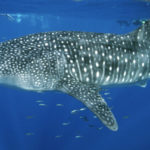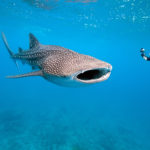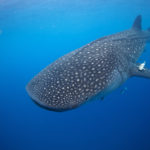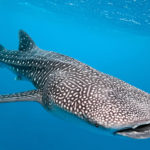Whale Shark
 The whale shark has been studied to a lesser degree than the rest of its relatives from the superclass of sharks of the cartilaginous fish class. It is rarely in the hands of ichthyologists for reasons of small size, huge size and transportation difficulties, because this is the largest shark in existence in the world. The size of the whale shark is second only to the estimated maximum size of the extinct megalodon.
The whale shark has been studied to a lesser degree than the rest of its relatives from the superclass of sharks of the cartilaginous fish class. It is rarely in the hands of ichthyologists for reasons of small size, huge size and transportation difficulties, because this is the largest shark in existence in the world. The size of the whale shark is second only to the estimated maximum size of the extinct megalodon.
For a long time it was unknown to scientists, only seamen who traveled in tropical waters knew about it. The meeting with such a giant, of course, surprised and frightened them, and these emotions contributed to the appearance of many beliefs about monsters living in the oceans.
What a whale shark looks like, zoologists learned for the first time in 1828. At that time in South Africa worked Andrew Smith, an English naturalist. He was given a small (4.50 m long) whale shark, mined in the Canton Bay, on the shore of which is the city of Cape Town. It is a small cove in the south-west of Africa in the Atlantic Ocean.
The whale shark has a unique appearance, on which it is recognized at a glance.
- A huge powerful body with a relatively small head.
- The head is flat, as if flattened, at the end of the snout this flattening is more pronounced.
- The mouth is terminal (located at the tip of the snout), most of all other sharks have a mouth under the snout.
- Width of mouth up to one and a half meters. With full disclosure, the mouth takes the form of a very wide oval.
- In the corners of the mouth, skinlike outgrowths, similar to small antennae, are clearly visible.
- Gill slits wide in number of five. They are long (up to 1.5 meters in a 12-meter specimen).
- Immediately behind the head, the trunk strongly thickens, forming a gentle hump, and then it becomes thinner.
- Dorsal fins in the number of two are closer to the caudal fin, the first of which is larger and similar to an equilateral triangle.
- The caudal fin is characteristic of all sharks – raznoplopastnoy, the length of the upper lobe is one and a half times higher than the lower one.
- Behind the head along the sides and back, the folds of the hide are evenly visible, which, like long ridges, extend to the tail.
- Large pectoral fins (up to 2.4 m long).
This is what a whale shark looks like through the eyes of the famous traveler Thor Heyerdahl: the description is quoted from his book (Tour Heyerdahl, The Expedition of Kon-Tiki, Ra, Translated from Norwegian by L. Zhdanov, Moscow: Mysl, 1972.)
“The head belonged to a gigantic monster, and it was so huge, so terrible that the sea serpent himself, appearing before us, would not hit us harder. Small eyes sat on the edges of a broad and flat muzzle, the toad mouth with a long fringe in the corners was not less than a meter and a half in width. The mighty trunk ended in a long thin tail; A sharp vertical fin testified that this was in any case not a whale. The body seemed brown in the water, but both it and the head were dotted with small white spots.
The monster slowly, lazily swam behind us, squinting like a bulldog and slowly working his tail. A large rounded dorsal fin protruded from the water, sometimes flickering and tail. And when the giant fell into the hollow between the waves, a wide back protruded, like a reef surrounded by whirlpools. Right before the mouth, a cloud of striped pilots floated fan; To a huge carcass sucked hefty stickers and other parasites – well, it’s an undersea stone with a whole colony of marine animals! … Even the rich imagination of Walt Disney could not have created a more terrible monster … ”
The maximum size of the whale shark was refined until the end of the 1990s, when the first reliable scientific information on the largest specimen of this fish species appeared: its length was 20 meters. How much does a whale shark of this size weigh? Its weight was 34 tons.
Ichthyologists use every opportunity to make measurements of different parts of the body of this sea giant. This happened in the southern state of Tamil Nadu in 2002 in India, when a young specimen was in the hands of Indian scientists. Scientists measured all the parameters of the body of its body with high accuracy:
- The length of the whale shark was 478 centimeters.
- The mouth was 77 centimeters wide.
- 115 centimeters was the length of the upper large lobe of the caudal fin.
- Parameters of the eye: length – 4 centimeters, and width – 3.5 centimeters.
Data were obtained on how much a whale shark weighs almost 5 meters: weight 1700 kg. Most often, people encounter whale sharks no larger than 12 meters.
Where does the whale shark live? Not in cold water. She loves warmth, and so she can be found in the low latitudes of all the oceans. The highest latitude, where it descends to the south and rises to the north – 40 degrees, but very rarely. Its habitual area is south of 30 degrees north and north of 35 degrees south latitude.
Scientists suggest that such preferences for water parameters in sharks are associated with a large number of planktonic organisms in these places, which form the basis of its diet. There is information that whale sharks have been seen even in the mouths of rivers, where the salinity is lower than the oceanic, but there are dense concentrations of plankton.



























